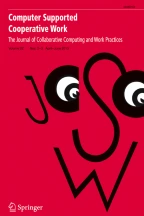Abstract
An activity theory model and a mediatingartifacts hierarchy were employed to helpidentify the needs for tools for customersupport engineers who documented solutions tocustomer problems, a knowledge authoringactivity. This activity also involves customersupport engineers who assist Hewlett-Packardsoftware product users. The particular toolsto be designed were knowledge-authoring toolsembedded in the customer support trackingapplication suite, SupportTracker. The researchanalyzed the role of tensions between theelements of Engeström's activity theorymodel. The research also explored the benefitsof specific interpretations of Engeström'srefinement of Wartofsky's mediating artifactshierarchy. The hierarchy contributed to theidentification of desired characteristics ofmediating artifacts, particularly tools. Thefindings included an interpretation of the``where-to'' artifact concept as supporting anunderstanding of the entire activity system asan evolving entity. Specific interventionswere used to achieve a positive impact on theevolution of the activity system.
Similar content being viewed by others
References
Basili, Victor (1980): Models and Metrics for Software Management and Engineering, IEEE Computer Society Press, IEEE Catalog No. EHO-167-7.
STARS Conceptual Framework for Reuse Processes (CFRP) (1993): Volume I: Definition, STARSVC-A018/001/00, September 30.
STARS Conceptual Framework for Reuse Processes (CFRP) (1993): Volume II: Application, STARS-VC-A018/002/00, September 30.
Collins, Patricia and Shilpa Shukla (1999): Ethnography to Inform Design: Activity Theory Methods for Software Design Requirements. UC-Irvine Bay Area Round Table Seminar, June.
Cornwell, Patricia et al. (1999): Practical Optimization Considerations for Diagnostic Knowledge Representation. AAAI Symposium: AI in Equipment Maintenance Service and Support, March.
Engeström, Yrjo (1990): When is a Tool? Multiple Meanings of Artifacts in Human Activity. In Yrjo Engeström (ed.): Learning, Working and Imagining. Painettu Kirjapaino Oma Ky:ssa, Jyvaskylassa.
Engeström, Yrjo (1999): Reigjo Miettinen, and Raija-Leena Punamaki (eds.): Perspectives on Activity Theory. New York: Cambridge University Press.
Grady, Robert (1998): Successful Software Process Improvement. Hewlett-Packard Press.
Hansen, Morten, Nitin Nohria and Thomas Tierney (1999): What's Your Strategy for Managing Knowledge? Harvard Business Review (March–April), pp. 106–116.
Kuutti, Kari (1996): Activity Theory as a Potential Framework for Human-Computer Interaction Research. In Bonnie A. Nardi (ed.): Context and Consciousness: Activity Theory and Human-Computer Interaction. Cambridge, Massachusetts: The MIT Press.
Nardi, Bonnie A. (ed.) (1996): Context and Consciousness: Activity Theory and Human-Computer Interaction. Cambridge, Massachusetts: The MIT Press.
Nonaka, Ikujiro and Hirotaka Takeuchi (1995): The Knowledge-Creating Company: How Japanese Companies Create the Dynamics of Innovation. Oxford University Press.
Pascale, Richard Tanner (1991): Managing on the Edge. Touchstone Books.
Peters, Tom (1991): Thriving on Chaos: Handbook for a Management Revolution. Harper Collins.
Senge, Peter M. (1990): The Fifth Discipline: The Art and Practice of The Learning Organization. New York: Doubleday Currency.
Shukla, Shilpa (1998): Hit Squads and Bug Meisters: Discovering New Artifacts to Facilitate Design of Workflow Process. At Fourth Congress of the International Society for Cultural Research aneo: Activity Theory and Cultural Historical Approaches to Social Practice, Aarhus University, Denmark, June 7–11.
Tournaire, Francoise and Richard Farrell (1996): The Art of Software Support: Design and Operation of Support Centers and Help Desks, Prentice Hall.
Vygotsky, L.S. (1978): Mind in Society. Harvard University Press.
Wartofsky, M. (1979): Models: Representation and Scientific Understanding. Dordrecht: Reidel.
Author information
Authors and Affiliations
Rights and permissions
About this article
Cite this article
Collins, P., Shukla, S. & Redmiles, D. Activity Theory and System Design: A View from the Trenches. Computer Supported Cooperative Work (CSCW) 11, 55–80 (2002). https://doi.org/10.1023/A:1015219918601
Issue Date:
DOI: https://doi.org/10.1023/A:1015219918601
